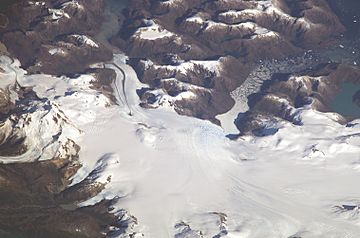Aguilera (volcano) facts for kids
Quick facts for kids Aguilera |
|
|---|---|

The volcano is visible in the leftmost portion of the image.
|
|
| Highest point | |
| Elevation | 2,546 m (8,353 ft) |
| Geography | |
| Location | Chile |
| Parent range | Andes |
| Geology | |
| Mountain type | Stratovolcano |
| Last eruption | 3,000 ± 1,000 years before present, but even more recent activity likely |
| Climbing | |
| First ascent | 2014 |
Aguilera is a tall stratovolcano in southern Chile. It stands high above the edge of the Southern Patagonian Ice Field. This volcano is quite remote. Scientists first realized it was a volcano in 1985. However, no one climbed it until 2014. This made Aguilera the very last major volcano in the Andes mountains to be climbed!
Aguilera is found west of Lake Argentino and northeast of Peel Fjord. It is part of the southern Andes mountain range. The volcano has erupted several times in the past. A big eruption happened about 3,000 years ago. Its eruptions have spread ash over Patagonia.
Contents
Where is Aguilera Volcano?
Aguilera is located west of the city of Calafate. It is also northwest of Peel Fjord. This volcano is in the commune of Natales. Not much was known about volcanoes in southern Chile and Patagonia for a long time. This is because they are hard to reach and the weather is often bad. Aguilera was named in 1933, but its volcanic nature was only confirmed in 1985.
Aguilera is part of the Austral Volcanic Zone in the Andes. This zone is in the southernmost part of Chile. It has six main volcanoes. From north to south, they are Lautaro, Viedma, Aguilera, Reclus, Monte Burney, and Cook. Most of these are stratovolcanoes, which are cone-shaped volcanoes. Aguilera is about 2,546 meters (8,353 feet) high. It rises from the Southern Patagonian Ice Field. Most of the volcano is covered in ice.
How Aguilera Volcano Formed
Volcanoes like Aguilera form because of how Earth's plates move. The Antarctic Plate is slowly sliding under the South America Plate. This process is called subduction. It causes the rocks deep inside the Earth to melt. This melted rock, called magma, then rises to the surface and forms volcanoes.
The rocks under Aguilera are very old. They are from the Paleozoic and early Mesozoic eras. The volcano sits near the edge of the Patagonian Batholith. This is a large area of igneous rocks.
Aguilera's magma is made of a type of rock called dacite. It also contains other minerals. The melted rock that forms Aguilera's magma comes from the subducting plate. It then mixes with other materials as it rises through the Earth's crust.
Climate and Plants Around Aguilera
The area around Aguilera is in the Westerlies belt. This means strong winds blow from west to east. The average temperature is about 4 to 10 degrees Celsius (39 to 50 degrees Fahrenheit).
There is a big difference in rainfall from west to east. The western side gets a lot of rain, about 1,400 millimeters (55 inches) per year. The eastern side gets much less, sometimes under 200 millimeters (8 inches) per year. This is because of orographic precipitation and the rainshadow effect. Mountains block the rain, creating a dry area on the other side.
The plants in the region change with the amount of water. You can find Magellanic subpolar forests in wet areas. In drier areas, there are semideserts. Many trees in the forests are Nothofagus species. These include Nothofagus antarctica, Nothofagus betuloides, and Nothofagus pumilio.
Aguilera's Eruption History
Aguilera has erupted several times during the Holocene period. This is the last 11,700 years. Its eruptions have left ash deposits in places like Lago Argentino and Torres del Paine. Scientists can tell which ash came from Aguilera based on where it landed. Other volcanoes in the area, like Cerro Hudson, have also left ash deposits.
Some ash layers suggest Aguilera erupted between 42,400 and 51,747 years ago. Later, two ash layers found in Torres del Paine National Park might be from Aguilera. These were from about 5,700 and 5,150 years ago. Another ash layer from 5,500 years ago also points to Aguilera.
An ash layer found near Lago Argentino is from Aguilera. It was deposited about 4,091 to 4,566 years ago. This eruption likely affected the people living there at the time. Ash found in Antarctica from 4,420 years ago might also be from Aguilera.
There are no known eruptions of Aguilera in recent history. However, some scientists think Aguilera might have erupted in 1886.
The A1 Eruption
A very large eruption happened at Aguilera about 3,000 years ago. It is known as the A1 eruption. This was a powerful eruption. It spread ash far to the east of the volcano. Ash reached as far south as the Strait of Magellan.
The A1 eruption was bigger than the 1991 eruption of Cerro Hudson. Scientists estimate its volume was between 3.6 and 9.5 cubic kilometers. This eruption is rated as level 5 on the volcanic explosivity index. This means it was a very strong explosion.
Ash from this eruption has been found in many places. These include Cordillera Baguales, Gran Campo Nevado, Lago Argentino, Lago Cardiel, Lago Roca, Lake Viedma, Brunswick Peninsula, Seno Skyring, Torres del Paine National Park, and Isla Grande de Tierra del Fuego. On Isla Grande de Tierra del Fuego, the eruption did not seem to affect people much. A layer of sulfur dioxide in ice cores from Talos Dome, Antarctica, also suggests this eruption.
First Climb of Aguilera
Aguilera was the last major volcano in the Andes to be climbed. A group of Chilean climbers successfully reached its summit in August 2014.
See also
 In Spanish: Volcán Aguilera para niños
In Spanish: Volcán Aguilera para niños

